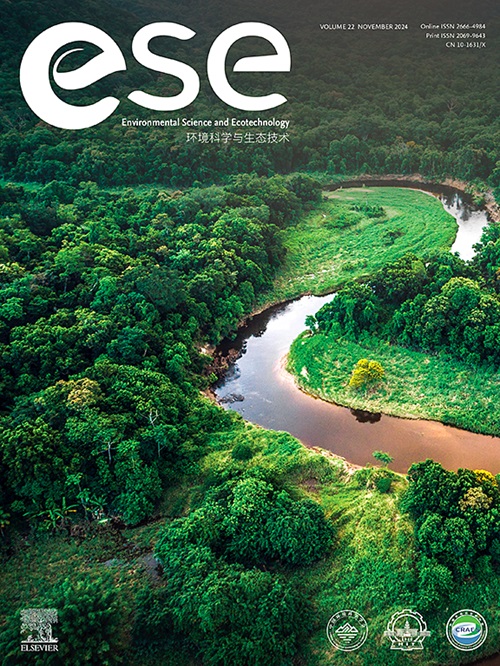淡水中纳米农药的生命周期风险评估
IF 14.3
1区 环境科学与生态学
Q1 ENVIRONMENTAL SCIENCES
引用次数: 0
摘要
传统的生态风险评估优先考虑下游的人为影响,忽略了涉及高度有害物质和间接排放的上游过程产生的风险。这种狭隘的焦点模糊了高风险的热点,使得传统的方法不适合评估新的化学实体。纳米农药是为靶向递送农药活性成分而设计的,越来越多地用于提高效率,然而,它们改变的环境命运和运输动态可能会重塑生命末期的风险,而其整个生命周期的影响仍不清楚。在这里,我们使用吡虫啉(IMI)及其纳米封装变体(nano-IMI)作为案例研究来解决这一差距。通过应用生命周期评估,并将USEtox生态毒性模型与纳米特异性SimpleBox4Nano框架相结合,我们量化了“从摇篮到闸门”的环境影响,并得出了特定物质的生态毒性指标,从而能够系统地表征与这些配方相关的生命末期风险。纳米IMI (4.63 × 103 CTUe)的生产阶段生态风险约为常规IMI (1.18 × 103 CTUe)的4倍。然而,考虑到降雨变率、毒性数据选择、命运和环境运输情景,纳米IMI排放(0.012-6.93 × 104 CTUe)的生命末期淡水生态风险比IMI (1.59 × 103-6.13 × 106 CTUe)低2-5个数量级。在相同的降雨条件下,纳米IMI的综合生命周期淡水生态风险降低了3个数量级,强调了其作为传统IMI的环保替代品的潜力。本研究介绍了一种全面而新颖的方法,用于评估工程纳米材料在现实环境中的替代品,为纳米农药在其整个生命周期中的风险评估提供了重要的见解。本文章由计算机程序翻译,如有差异,请以英文原文为准。

A life cycle risk assessment of nanopesticides in freshwater
Conventional ecological risk assessments prioritize downstream anthropogenic impacts, overlooking risks arising from upstream processes involving highly hazardous substances and indirect emissions. This narrow focus obscures high-risk hotspots and renders traditional methodologies ill-suited for evaluating novel chemical entities. Nanopesticides, designed for targeted delivery of pesticidal active ingredients, are increasingly deployed to enhance efficiency, yet their altered environmental fate and transport dynamics may reshape end-of-life risks while their full lifecycle impacts remain uncharacterized. Here, we address this gap using imidacloprid (IMI) and its nano-encapsulated variant (nano-IMI) as case studies. By applying life cycle assessment and integrating the USEtox ecotoxicity model with the nano-specific SimpleBox4Nano framework, we quantify "cradle-to-gate" environmental impacts and derive substance-specific ecotoxicity metrics, enabling systematic characterization of end-of-life risks associated with these formulations. Production-stage ecological risks of nano-IMI (4.63 × 103 CTUe) are approximately four times greater than those for conventional IMI (1.18 × 103 CTUe). However, end-of-life freshwater ecological risks from nano-IMI emissions (0.012–6.93 × 104 CTUe) are 2–5 orders of magnitude lower compared with IMI (1.59 × 103–6.13 × 106 CTUe), accounting for rainfall variability, toxicity data selection, fate, and environmental transport scenarios. Under equivalent rainfall conditions, nano-IMI exhibited up to three orders of magnitude lower integrated life-cycle freshwater ecological risks, underscoring its potential as an environmentally preferable alternative to conventional IMI. This research introduces a comprehensive and novel methodology for evaluating engineered nanomaterial alternatives across realistic environmental scenarios, providing essential insights into nanopesticide risk assessment throughout their lifecycle.
求助全文
通过发布文献求助,成功后即可免费获取论文全文。
去求助
来源期刊

Environmental Science and Ecotechnology
Multiple-
CiteScore
20.40
自引率
6.30%
发文量
11
审稿时长
18 days
期刊介绍:
Environmental Science & Ecotechnology (ESE) is an international, open-access journal publishing original research in environmental science, engineering, ecotechnology, and related fields. Authors publishing in ESE can immediately, permanently, and freely share their work. They have license options and retain copyright. Published by Elsevier, ESE is co-organized by the Chinese Society for Environmental Sciences, Harbin Institute of Technology, and the Chinese Research Academy of Environmental Sciences, under the supervision of the China Association for Science and Technology.
 求助内容:
求助内容: 应助结果提醒方式:
应助结果提醒方式:


